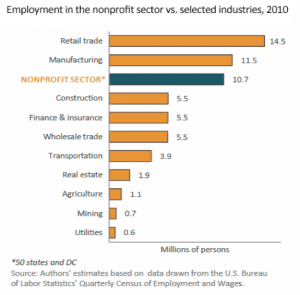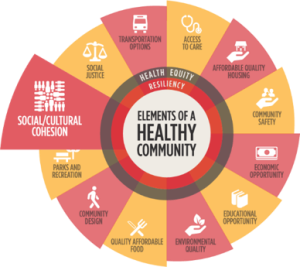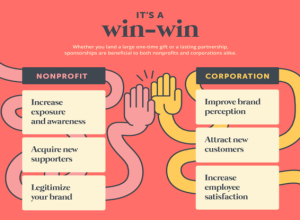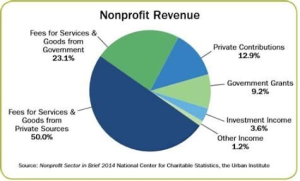6
Introduction
Non-profits are one of the various methods that can be used to promote sustainability. They are one of the main groupings that organizations fall into: for-profit, non-profit, and government. Depending on the focus of the non-profit, they can prove useful in any of the three pillars of sustainability. Unlike for-profit businesses, non-profits are specifically designed to meet a defined goal and produce results, and this makes them perfect for activism, research, and other actions which are important to sustainability. A non-profit transpires when an individual or group identifies an important issue that they feel is not being effectively met by other structures or systems that are already in place. The non-profit is formed in support of this issue and designed to provide the specific services that it calls for. In this way, non-profits are the technique to fill the gaps between people’s needs and values and their socioeconomic system’s current provisions. They allow stakeholders to create an organization centred around taking action for the environmental, social, and economic issues which are vital to them. This chapter will cover basic information about non-profits, such as qualifications and qualities of non-profits, how they differ from other types of organizations, what functions they serve for society, and how their design serves an important purpose in sustainability.
The Importance of Non-profits to Sustainability
Improving societal sustainability involves the different ways that we take action to try to protect social, environmental, and economic wellbeing. This can include work on issues like education, pollution, community health, safety, and culture, and many more aspects of human life. Non-profits are vital to sustainable action for many reasons. To begin with, governments and businesses do not have the resources to address and provide for all human needs. Many social issues such as poverty, homelessness, racial inequality, homophobia, sexism, ableism, lack of access to food, and others are not adequately being addressed. These can be addressed with tactics such as advocacy and charitable organizations which provide vital resources. Environmental issues such as GHG emissions, climate change, pollution, or others can be addressed by non-profits who perform research, creating a valuable knowledge base.
Issues like these can occur on a large scale across nations or on a small scale within different communities. They are complex and differ across communities, so the time, money, and work required to work with them is significant. Since governments need to serve large and diverse populations and many different stakeholder groups, it can be difficult for them to fully advocate for each issue or need. On the other hand, non-profits are born from the needs of the people. They are organized around an identified cause and are focused wholly on serving that cause. This makes non-profits an ideal way to fill in the gap between society’s needs and what is provided by governments and for-profits.
In addition to this, non-profits bring people together around a common cause. As individuals learn to collaborate and share values, this brings the community closer together and improves social cohesion. Non-profits also frequently involve community-building missions. For example, organizations which offer a place to practice organized religion as a community are non-profits. Many non-profits may be oriented around the arts, such as a community theatre. Whatever service they are offering, non-profits are oriented around improving community wellbeing. They have the capacity to create a more educated, healthy, aware, fair, and connected environment. Non-profits offer a way for people to get involved in the issues they care about and allows them to have a role in creating the change that they want to see. Non-profits organize and utilize an otherwise untapped workforce of volunteers and use this to meet otherwise unmet ends. They provide a way to match those who can help with those who need help, and for these reasons they are extremely important to sustainable efforts.
What is a Non-profit?
A non-profit is a type of private organization which has a stated purpose related to improving public wellbeing and is not a part of the government. The mission of a non-profit guides all the actions that it takes and is the sole focus and purpose of the organization. This mission can be directed towards a local community as a whole or it can be oriented to provide support to a certain group of people. For example, there are many non-profit organizations which are focused on providing necessities to homeless populations and many designed to educate or provide for children, improving social sustainability through community development. Non-profits are not always charitable organizations, and often have different purposes. Some common purposes include scientific research, public education, religion, and the arts.
Contrary to the name, non-profit does not mean that the business cannot make a profit. They are called non-profits because they are not made for the purpose of generating profit for any ‘owners,’ instead they are made to meet a specific mission or goal, usually focused on environmental or social wellbeing. Non-profits, unlike for-profit corporations, usually do not have owners; instead, they have a board of directors and officers and staff. While non-profits do have many people who volunteer their time and effort, they also often have a full-time, paid staff. Non-profits may acquire funds through methods such as fund-raisers, partnerships, and grants to name a few. Any profit made by a non-profit must be used towards their mission, which could mean salary for employees, for supplies needed, and similar purposes. Non-profits are formed to meet needs that are not currently being addressed by for-profit businesses or governments. For example, Red Cross is a large non-profit who saw that there was a need in hospitals for donated blood, so an organization was created to inform people of this need and give them a place to contribute both by donating and by volunteering time and work. A social need was identified and an organization where people could consolidate their efforts to be most effective was created. It allowed the average person to contribute to a sustainable cause, whether or not they were involved with it or aware of it before. This makes the ability to take sustainable action more accessible and increases awareness of the issue.

The number of individuals employed by non-profits in the US as of 2010 in millions.
Photo Credit: http://ccss.jhu.edu/new-report-nonprofits-show-job-growth-through-decade-of-turmoil-but-lose-market-share/
Non-profits come in many different sizes as well. Smaller organizations tend to have much lower budgets but are still capable of providing significant impacts through utilizing volunteers. They may be more likely to rely on volunteers and little to no full-time staff. Average sized organizations tend to have a combination of volunteers and full-time staff, and larger organizations often have a large staff and a large number of volunteers as well. This is because they often have a larger budget but also because they tend to be more well-known and widespread. Because of the way non-profits are designed, these employees frequently earn salaries lower than what would be expected of a similar job and education level in a for-profit business.
Non-profit Functions
Non-profits are not motivated by income, they are interested in the forward progress of a societal group, if not society as a whole. Every non-profit has a different function in society, they will fit under: Service, advocacy, expression, or community building – as described in Lester Salomon’s Five Roles and Functions of Non-profits. Every non-profit contributes to sustainability in some way, whether it be socially, environmentally, or economically. Some of these organizations tackle issues within multiple pillars of sustainability.
Service Function
Many non-profits aim to serve the public with life necessities such as healthcare and education. Many hospitals are non-profits; the bills you pay for using these hospitals are paired with government aid to pay used utilities and workers – none of the income goes to shareholders. Similarly, Higher Education Institutions (HEI’s) are almost entirely non-profits. Tuition funds are used to run the institution as well as pay staff and faculty.
Non-profits providing a service help to make society more social and economically sustainable with their inclusive “by the people for the people ” mentality. If, for example, all healthcare facilities were for-profit businesses, the price for their service would depend on what was most profitable. Those who cannot afford their services but need them would be left out and priority would go to the upper class. The non-profit system assures that service goes to those in need equitably.
Advocacy Function
Advocacy non-profits aim to inform and influence decision making by businesses, governments, and people of power. Many of these types of organizations can be seen in the media, at rallies, and on university campuses. Advocacy based non-profits tend to create a more socially sustainable environment for members of a large community by giving people a voice. If there is a disconnect between decision makers and members of a constituency, advocacy non-profits can act as a liaison. It is common to see these organizations playing the role of the Boundary Spanner in a large, cooperative system of people.
The United States would have a completely different outlook if it were not for the efforts of advocacy organizations. The National Association for the Advancement of Colored People (NAACP) is a great example of non-profits making societal impacts. The NAACP was founded in 1909, long before segregation ended in 1964. Their persistent efforts slowly but effectively gave icons like Rosa Parks and Dr. Martin Luther King Jr. a platform to advocate for equal rights amongst all people. Without the NAACP and their advocates, many Americans would not be given the moral rights they deserve today.
Expressive Function
The expressive function generally supports arts, athletics, and social groups. These things do not have much of a market around them and they need to be supported in other ways. Recreational sports exemplify expressive nonprofits for athletics. Recreational sports are run by a town’s recreation department, not by a business. They pay for uniforms and referees with members participation fees; they do not run the league for a profit. Churches follow the same concept by accepting donations to offer Mass. They must pay bills and offer employee housing.
These non-profits contribute to sustainability by giving a platform to social necessities that do not bring in much profit – like arts, athletics, and religious faiths. These things need to be represented in our country, but they would not be able to economically sustain without a non-profit organization paying the bills. Arts, athletics, faiths, etc are vital cultural staples in a society, they bring morale and enjoyment to people while creating cultural identity. The YMCA exemplifies this function by offering a variety of expressive programs.
Case Study: YMCA
Founded in 1844, the YMCA is one of the oldest and largest youth-focused movements in the world. The non-profit has regional, local, national facilities and a ‘world’ program called World YMCA. The non-profit offers a plethora of programs and services that cover all 17 of the United Nations Sustainable Development Goals. Their goal is to connect communities, empower younger generations, and bring social justice and peace to families regardless of social class, gender, religion, or race. Within local communities, YMCA integrates people together using the expressive function through art, recreation, outdoor enrichment and so much more.
The YMCA offers a plethora of activities, especially for kids, to get active, outside, and meet new kids. These activities not only allow for social cohesion but are also an economic benefit as some parents who do not have enough money for babysitters can take their kids to the after-school programs the YMCA offers. Camps are known for being extremely expensive, leaving the majority of US kids at home in the summer as their parents cannot afford it. The YMCA confronts that issue and offers free summer camps to those who cannot afford it. As stated previously, this allows kids to develop their skills in arts, athletics and much more while their parents are at work. These camp programs offered by the YMCA also allow underprivileged kids to have free meals while they are at camp, which is a stride toward quality of life for all. Overall, the YMCA as a non-profit develops programs that work towards sustainability goals using the expressive function.
Community Building Function
Cohesion within a community builds resilience, and many non-profits provide a community building function through aiming to strengthen communities. Community building non-profits promote social cohesion and “togetherness” in an area. This can be as simple as like-minded social media groups, to as advanced as widespread philanthropy groups.
When discussing community building non-profits, Greek life, a popular factional group amongst university and college campuses all over America, is a good comparison. All fraternity and sororities are non-profits as they cycle money from participation into housing, scholarships and member growth. A staple of joining a fraternity or sorority is partaking in philanthropy. Philanthropy events aim to support members of the community and spread awareness while having fun. Greek organizations contribute to social sustainability by offering public service and building social cohesion on campuses.

A diagram showing the different factors necessary to establish a healthy community.
Photo Credit: https://livewellaz.org/tag/social-and-cultural-cohesion/
Oftentimes, non-profits contribute to their community’s cohesion as a result of pursuing another function. Services, advocacy, and expressive platforms tend to make communities stronger and better places to live. Many consider these non-profits cross-cutting nonprofits since they satisfy multiple functions. Most of the community building from non-profits is the product of a different success.
Assisting marginalized groups
An extremely important benefit of a charitable organization and the main goal that every non-profit works to achieve is assisting groups who have lacked representation. Non-profits aim to give a voice to those who have not had the ability to be heard. They strive to address common societal issues and essentially work to convenience marginalized groups. Non-profits employ over 12 million people nationally. They provide job security and contribute to the stabilization of our economy. In many cases, non-profits provide some sort of service that often includes social benefits. A non-profit could aid an underprivileged community in the building of a public playground creating social cohesion. It could provide hospitalization and health care to those requiring assistance. A non-profit could implement a compost system contributing to a community’s social and environmental well-being.
Partnerships
An appeal of non-profits from an economic stance are partnerships. When businesses collaborate with non-profits, not only do they appear philanthropic, but they can generate profit contributing to company growth with more charitable income. Each party will benefit by receiving the clients and members of the other. The non-profit will gain publicity and establish public relations serving as a social benefit of the partnership. Partnerships expose all parties involved to a collaborative process and a wide range of perspective. They allow for this process to take place while also creating shared value. This is the concept of supporting similar industries while being able to work within a fixed community to create policies that enhance the competitiveness of a company. Additionally, non-profits can partner with environmentally supportive organizations. For example, Partners for World Health is a non-profit during partnering with Tufts Medical Centre in Boston. Together, they are working to implement a new recycling program for unused supplies which boosts their sustainable output.

A visual depicting the benefits to non-profits and to corporations resulting from their partnership.
Photo Credit: https://www.classy.org/blog/corporate-sponsorships-for-nonprofits-the-basics/
Case Study: Partners for World Health
Partners for World Health is a non-profit, founded by Elizabeth McLellan, that is based out of Portland, Maine. McLellan’s work as a nurse sent her to Saudi Arabia, where she observed the unsanitary and limited medical care in developing places. Nevertheless, it’s also when she realized the wasteful practices in the states and from then on, she envisioned an organization that could help. Partners for World Health collect medical supplies and equipment from healthcare facilities, manufacturers, other organizations, and even individuals in the community who are willing to help. After the non-profit sorts and evaluates the supplies they receive, they can then send to communities, individuals and healthcare facilities in need. This not only limits supplies going to the landfills, reducing the impact on the environment, but it also lowers healthcare costs because of lowered disposal fees; researchers reported that it costs approximately $10 billion each year to remove the unused or wasted supplies from facilities. Another reason for wasted medical supplies is simply because the materials have expiration dates and due to laws about retaining expired goods in medical facilities, they must be discarded in the United States. By donating supplies, this provides healthcare resources to those in need, particularly in developing countries. In order for this non-profit to function, they need donations from outside sources.
Hospitals, clinics, and doctors’ offices are just a few entities that can donate to Partners for World Health. When an organization or medical facility donates, they are not only lowering their fees for disposal but also lowering their negative impact on the environment as well as giving supplies to those in need. All donations are tax deductible as well, making it beneficial to all parties involved; other health institutions donating only pay shipping costs. A big part of what Partners for World Health acts on is allocating what would have been ‘expired’ or wasted medical supplies in the United States to developing countries. These countries are often short on equipment such syringes, gloves, masks and even oxygen- all basic medical supplies. The World Health Organization states that “80% of the medical equipment used in developing countries has been donated from other places or organizations.” This not only helps lower fees in the United States and helps our economy but helps the people in developing countries who do not get basic medical supplies for their care. Additionally, Partners for World Health aspires to expand medical missions and continue finding new ideas to reach different communities. They have already started their efforts with Project 10,000 and their partnerships with women living in brothels. Immensely contributing to sustainability, this non-profit grants those in need with free, clean medical supplies they would not have otherwise and by creating social cohesion in communities.
Non-profits and the Government
Non-profits have valuable experiential knowledge with their communities and subjects which governments often will make use of. They are often contracted by the government to help provide more effective resources to the public. In addition, while non-profits often address issues that the government is not addressing, they also often work on similar projects. They can expand the government’s capacity to offer a good or service with their resources or can supplement a government program with additional goods and services. In these cases, they may expand what is being done or use their knowledge, experience, or advocative abilities to enhance the quality of the efforts being made.
Funding
Non-profits all have individual missions, but one of the goals they all have in common is establishing and maintaining a steady stream of funding. For larger non-profits, the main source of funds is fees for services provided by the organization as well as the selling of products. For example: a non-profit sets up a weeklong inner city food drive at City Hall. Unlimited supplies are provided: canned goods, microwavable meals etc. Each person pays a flat rate of $10 and takes whatever it is they need. This qualifies as a membership fee. $10 may not seem like a significant amount, but if ten people attend the drive, the non-profit has earned $100 and provided an extremely helpful service. Small non-profits rely more heavily on donations and charitable grants. These donations can come from anywhere: private, corporate, or family foundations. However, over half of charitable donations received by non-profits come from the individual. Individual donations and public support are important to the stability of a non-profit because if there is enough, they may be qualified for tax exemptions or grants from the government.

A model showing the distribution of various sources of income for non-profits in 2014.
Photo Credit: https://grantspace.org/resources/knowledge-base/how-are-nonprofits-funded/
Case Study: World Wildlife Fund
Present in more than 100 countries the World Wildlife Fund is the world’s leading conservation organization. While human activities are the leading cause of biodiversity and ecosystem loss the World Wildlife Fund believes people also have the power to change course. The WWF works with communities to protect wildlife species who are on the brink of extinction, while also improving food availability for all, conserve forests, and so much more. Within the few examples listed of the WWF, they address the environmental pillar as well as the social equity pillar. While this may seem peculiar for a non-profit such as the WWF, the organization also touches on the economic pillar. To address and combat all these issues this non-profit needs a lot of funding.
The World Wildlife Fund requires donations, volunteers, interns, and yearly employees to reach their sustainable goals. Without funding, the non-profit would not be able to reach their goals toward a more sustainable world. The WWF promotes funding through various avenues. Along with many other non-profits, they have merchandise which can be purchased on their website as well as the symbolic adoption of an animal. They also have fundraising events throughout the year as well as simple donations on their website to raise money to fund their endeavours. Within 2018 the WWF engaged in efforts to promote social equity, environmental protection, and even economic viability for the United States. In April of 2018, due to the WWF advocacy team, the non-profit finally pushed for the US government to enforce new rules aimed at stopping illegal seafood from the US market. This provides further financial support to local, US fishermen, as more people will be pushed to buy from them, which feeds right back into the US economy. This also supplies the local fisherman with more money, allowing them to expand business and live a better life altogether. Expanding globally, the WWF supported ministers from Bolivia, Brazil, and Paraguay to sign a trinational declaration to protect the Pantanal, which happens to be the world’s largest tropical wetland. This agreement not only ensures protection for the environmental area, but also social and economic development as indigenous and traditional populations inhibit within the Pantanal region. Without the numerous donations the World Wildlife Fund receives, these sustainability efforts would not be possible.
Chapter Summary
Non-profits are designed to work for the people and causes, not for profit. They help to create functioning, safe, equitable, and connected communities and give a platform for people to speak to their values. While they have their difficulties, such as funding and strict legal requirements, their strengths that arise from groups, communities, and individuals who are motivated to help and provide valuable services, allows them to create significant change. Like entrepreneurs, they see problems as opportunities to innovate and places to improve. Their different functions are vital to a community’s wellbeing, and, large or small, non-profits hold an important position in sustainability.
Comprehension Questions
- Why are non-profits important to sustainability?
- What is the focus of a non-profit? What is different about this from for-profit businesses?
- What are some of the common difficulties faced by non-profits?
- What are the 5 different functions of non-profits?
A form of private organization which is separate from the government but is still oriented around public wellbeing.
A form of private organization, which is designed to create profit for its owners, the shareholders, as well as its valued stakeholders.
Social cohesion is a measure of the connection among members of a community which can be seen in the extent to which the individuals in a community feel connected and how much they communicate and collaborate with each other.
When an issue, organization, or practice involves different parts of a system either by being an interrelated problem involving multiple factors or a solution whose implementation impacts multiple areas.
Policies and operating practices that enhance the competitiveness of a company while simultaneously advancing the economic and social conditions in the communities in which it operates.
Knowledge accumulated through life experiences either at work or specific geographic area
